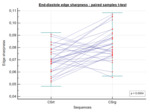Keywords:
Outcomes, Imaging sequences, Image compression, MR, Cardiovascular system, Cardiac
Authors:
B. Longere, L. Grenier, J. PAGNIEZ, V. Silvestri, A. Simeone, K. KASPRZAK, F. Pontana; Lille/FR
Results
30 patients (22 males) were referred for: heart valve disease (n=9), ischemic cardiopathy (n=8), myocarditis (n=5), left ventricular hypertrophy (n=5) and infiltrative cardiomyopathy (n=3). Mean age was 48.0 ± 21.0 years-old. All patients could fully complete CSrt and CSrg breath-holdings.
Mean scan time was 485.4 ± 83.3 s (95 % CI: 454.3 to 516.5) using SSFPref. Regarding CS accelerated sequences, mean scan time was 23.9 ± 5.2 s (95 % CI: 21.9 to 25.8) with CSrt and 58.3 ± 15.1 s (95 % CI: 53.7 to 64.2) with CSrg (p < 0.0001).
Compared to SSFPref, the mean acceleration factor reached by CSrg was 8.4 (95 % CI: 7.5 to 9.3). A mean number of 15.0 ± 1.2 slices (95 % CI: 14.6 to 15.4) was acquired with each technique.
The CSrg prototype demonstrated a significantly better edge sharpness than CSrt (CSrg = 0.083 ± 0.013 pixel-1 [95 % CI: 0.078 to 0.087] versus CSrt = 0.070 ± 0.011 pixel-1 [95% CI: 0.066 to 0.074]; p = 0.0004) (Fig. 4).
Moreover, no significant difference was demonstrated between CSrg and SSFPref (CSrg = 0.083 ± 0.013 pixel-1 [95 % CI: 0.078 to 0.087] versus SSFPref = 0.075 ± 0.016 pixel-1 [95% CI: 0.069 to 0.081]; p = 0.0516) (Fig. 5).
Good agreement were yielded by Bland-Altman and linear regression analyses for both LV (R² > 0.92) and RV (R² > 0.89). No significant difference was demonstrated regarding LVM or LV and RV volumes (EDV, ESV, SV) and EF (p > 0.05) (Table 1).
Intra-rater agreement was excellent, demonstrating intraclass correlation coefficient (ICC) greater than 0.99 for both ventricles. So were inter-rater agreement for LV (ICC ≥ 0.97) and RV (ICC ≥ 0.96).




